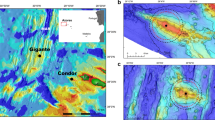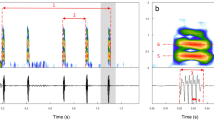Abstract
Many fish species produce sounds as a part of their reproductive behavior. Using passive acoustic recording approaches, these sounds can be used to document temporal and spatial patterns of reproductive activity of fish populations. We conducted an 11-month passive acoustic survey at three different locations off the coasts of Georgia (40 km north of Grays Reef National Marine Sanctuary) and North Carolina (Onslow Bay) to understand the spawning phenology of two species of acoustically active fishes: black drum (Pogonias cromis) and toadfish (Opsanus sp.). Due to the depth of the recording locations, we could not confirm whether the toadfish calls were produced by O. tau, or another Opsanus species. Both taxa have readily identifiable, distinct sounds. Chorusing sounds from both species were detected at all three Georgia sites and at two of the three North Carolina locations; chorusing duration of both species was greater in Georgia. The onset and duration of chorusing activity for both species was correlated with water temperature. The abundance of calls of these two species from field recordings further demonstrates the value of long-term passive acoustic surveys for understanding the reproductive seasonality of acoustically active fish species.








Similar content being viewed by others
References
Avise JC, Reeb CA, Saunders NC (1987) Geographic population structure and species differences in mitochondrial DNA of mouthbrooding marine catfishes (Ariidae) and demersal spawning toadfishes (Batrachoididae). Evolution 41:991–1002. doi:10.2307/2409187
Barimo JF, Fine ML (1998) Relationship of the swim-bladder shape to the directionality pattern of underwater sound in the oyster toadfish. Can J Zool 76:134–143. doi:10.1139/z97-160
Bass AH, Ladich F (2008) Vocal-acoustic communication: From neurons to behavior. In: Popper AN, Fay RR, Webb JF (eds) Springer handbook on auditory research. Springer, New York, pp. 253–278. doi:10.1007/978-0-387-73029-5_8
Bass AH, McKibben JR (2003) Neural mechanisms and behaviors for acoustic communication in teleost fish. Prog Neurobiol 69:1–26. doi:10.1016/S0301-0082(03)00004-2
Bioacoustics Research Program (2012) XBAT R6: Extensible bioacoustics tool. Cornell Lab of Ornithology, Ithaca, NY. Available at: http://www.birds.cornell.edu/brp/software/xbat-introduction
Bioacoustics Research Program (2014) Raven Pro: Interactive sound analysis software (Version 1.5). Cornell Lab of Ornithology, Ithaca, NY. Available at: http://www.birds.cornell.edu/brp/raven/
Bureau of Ocean Energy Management (2014) Environmental assessment for potential interim policy lease issuance and site assessment activities on the Atlantic Outer Continental Shelf (OCS) offshore Georgia. Fed Reg 79:18578–18579
Calupca TA, Fristrup KM, Clark CW (2000) A compact digital recording system for autonomous bioacoustic monitoring. J Acoust Soc Am 108:2582
Chao NL (2002) Croakers (drums). In: Carpenter KE (ed) FAO species identification guide for fisheries purposes the living marine resources of the western Central Atlantic, Vol 3 bony fishes, part 2 (Opistognathidae to Molidae), sea turtles and marine mammals. Food and Agricultural Organization of the United Nations, Rome, pp. 1583–1653
Collette BB (2002) Toadfishes. In: Carpenter KE (ed) FAO species identification guide for fisheries purposes the living marine resources of the western Central Atlantic, Vol 2 bony fishes, part 1 (Acipenseridae to Grammatidae). Food and Agricultural Organization of the United Nations, Rome, pp. 1026–1042
Conley MC, Anderson MG, Geselbracht L, Newton R, Weaver, KJ, Barnett, A, Prince, J (2015) The South Atlantic Bight marine assessment: Species, habitats and ecosystems. The Nature Conservancy, Eastern U.S. Division, Boston, MA. Available at: http://nature.ly/marineSAtlanticBightERA
D’Spain GL, Batchelor HH (2006) Observations of biological choruses in the Southern California bight: a chorus at midfrequencies. J Acoust Soc Am 120:1942–1955. doi:10.1121/1.2338802
Department of the Navy (2009) Essential fish habitat assessment for the Environmental Impact Statement/Overseas Environmental Impact Statement: Undersea Warfare Training Range. Contract Number: N62470–02-D-9997. Department of the Navy, NAVFAC Atlantic, Norfolk, VA
Edds-Walton PL, Mangiamele LA, Rome LC (2002) Variations of pulse repetiiton rate in boatwhistle sounds from oyster toadfish Opsanus tau around Waquoit Bay, Massachusetts. Bioacoustics 13:153–173. doi:10.1080/09524622.2002.9753493
Fay RR, Edds-Walton PL (1997) Diversity in frequency response properties of saccular afferents of the toadfish, Opsanus tau. Hear Res 113:235–246. doi:10.1016/S0378-5955(97)00148-2
Figueroa H, Robbins M (2008) XBAT: an open-source extensible platform for bioacoustic research and monitoring. In: Frommolt K-HF, Bardeli R, Clausen M (eds) Computational bioacoustics for assessing biodiversity: proceedings of the international expert meeting on IT-based detection of bioacoustical patterns, December 2007 at the International Academy for Nature Conservation. BfN, Bonn, Germany, pp 143–155
Fine ML (1978) Seasonal and geographical variation of the mating call of the oyster toadfish Opsanus tau L. Oecologia 36:45–57. doi:10.1007/BF00344570
Fine ML, Thorson RF (2008) Use of passive acoustics for assessing behavioral interactions in individual toadfish. Trans Am Fish Soc 137:627–637. doi:10.1577/T04-134.1
Fine ML, Winn HE, Joest L, Perkins PJ (1977) Temporal aspects of calling behavior in oyster toadfish, Opsanus tau. Fish Bull 75:871–874
Fish MP, Mowbray WH (1970) Sounds of Western North Atlantic fishes: a reference file of biological underwater sounds. The Johns Hopkins Press, Baltimore
Fitzhugh GR, Thompson BA, Snider TG (1992) Ovarian development, fecundity, and spawning frequency of black drum Pogonias cromis in Louisiana. Fish Bull 91:224–253
Frisbie CM (1961) Young black drum, Pogonias cromis, in tidal fresh and brackish waters, especially in the Chesapeake and Delaware Bay areas. Chesapeake Sci 2:94–100 doi:10.2307/1350727
Gray GA, Winn HE (1961) Reproductive ecology and sound production of toadfish, Opsanus tau. Ecology 42:274–282. doi:10.2307/1932079
Gudger EW (1910) Habits and life history of the toadfish (Opsanus tau). Bull US Bur Fish 28:1071–1109
Hughes AR, Mann DA, Kimbro DL (2014) Predatory fish sounds can alter crab foraging behaviour and influence bivalve abundance. Proc R Soc B 281:20140715. doi:10.1098/rspb.2014.0715
Isaacson PA (1964) Summer movement of the toadfish, Opsanus tau. Ecology 45:655–656. doi:10.2307/1936123
Kendall MS, Jensen OP, Alexander C, Field D, McFall G, Bohne R, Monaco ME (2005) Benthic mapping using sonar, video transects, and an innovative approach to accuracy assessment: a characterization of bottom features in the Georgia bight. J Coast Res 21:1154–1165. doi:10.2112/03-0101R.1
Kendall MS, Bauer LJ, Jeffrey CFG (2007) Characterization of the benthos, marine debris and bottom fish at Gray’s Reef National Marine Sanctuary. NOAA Technical Memorandum NOS NCCOS 50. National Centers for Coastal Ocean Science and National Marine Sanctuary Program, Silver Spring, MD, p. 1–82
Kritzer JP, DeLucia M-B, Greene E, Shumway C, Topolski MF, Thomas-Blate J, Chiarella LA, Davy KB, Smith K (2016) The importance of benthic habitats for coastal fisheries. BioScience 66:274–284. doi:10.1093/biosci/biw014
Lillis A, Eggleston DB, Bohnenstiehl DR (2014) Estuarine soundscapes: distinct acoustic characteristics of oyster reefs compared to soft-bottom habitats. Mar Ecol Prog Ser 505:1–17. doi:10.3354/meps10805
Locascio JV, Mann DA (2011a) Diel and seasonal timing of sound production by black drum (Pogonias cromis). Fish Bull 109:327–338
Locascio JV, Mann DA (2011b) Localization and source level estimates of black drum (Pogonias cromis) calls. J Acoust Soc Am 130:1868–1879. doi:10.1121/1.3621514
Locascio JV, Burghart S, Mann DA (2012) Quantitative and temporal relationships of egg production and sound production by black drum Pogonias cromis. J Fish Biol 81:1175–1191. doi:10.1111/j.1095-8649.2012.03376.x
Lowerre-Barbieri SK, Barbieri LR, Flanders JR, Woodward AG, Cotton CF, Knowlton MK (2008) Use of passive acoustics to determine red drum spawning in Georgia waters. Trans Am Fish Soc 137:562–575. doi:10.1577/T04-226.1
Luczkovich JJ, Pullinger RC, Johnson SE, Sprague MW (2008) Identifying sciaenid critical spawning habitats by the use of passive acoustics. Trans Am Fish Soc 137:576–605. doi:10.1577/T05-290.1
Macchi GJ, Acha EM, Lasta CA (2002) Reproduction of black drum (Pogonias cromis) in the Rio de la Plata estuary, Argentina. Fish Res 59:83–92. doi:10.1016/S0165-7836(01)00410-6
Mahon R, Brown SK, Zwanenburg KCT, Atkinson DB, Buja KR, Claflin L, Howell GD, Monaco ME, O’Boyle RN, Sinclair M (1998) Assemblages and biogeography of demersal fishes of the east coast of North America. Can J Fish Aquat Sci 55:1704–1738. doi:10.1139/cjfas-55-7-1704
Mann DA, Grothues TM (2009) Short-term upwelling events modulate fish sound production at a mid-Atlantic Ocean observatory. Mar Ecol Prog Ser 375:65–71. doi:10.3354/meps07720
Mann DA, Jarvis SM (2004) Potential sound production by a deep-sea fish. J Acoust Soc Am 115:2331–2333. doi:10.1121/1.1694992
Maruska K, Mensinger A (2009) Acoustic characteristics and variations in grunt vocalizations in the oyster toadfish Opsanus tau. Environ Biol Fish 84:325–337. doi:10.1007/s10641-009-9446-y
McCauley, RD (2012) Fish choruses from the Kimberley, seasonal and lunar links as determined by long term sea noise monitoring. Proceedings of Acoustics 2012 - Freemantle:1–6
McCauley RD, Cato DH (2000) Patterns of fish calling in a nearshore environment in the Great Barrier Reef. Phil Trans R Soc B 355:1289–1293. doi:10.1098/rstb.2000.0686
Mok HK, Gilmore RG (1983) Analysis of sound production in estuarine aggregations of Pogonias cromis, Bairdiella chrysoura, and Cynoscion nebulosus (Sciaenidae). Bull Inst Zool Acad Sinica 22:157–186
Montie EW, Vega S, Powell M (2015) Seasonal and spatial patterns of fish sound production in the May River, South Carolina. Trans Am Fish Soc 144:705–716. doi:10.1080/00028487.2015.1037014
Murphy MD, Taylor RG (1989) Reproduction and growth of black drum, Pogonias cromis, in Northeast Florida. Northeast Gulf Sci 10:127–137
Nieland DL, Wilson CA (1992) Reproductive-biology and annual variation of reproductive variables of black drum in the northern Gulf of Mexico. Trans Am Fish Soc 122:318–327. doi:10.1577/1548–8659(1993)122 <; 0318:RBAAVO > 2.3.CO;2
Ramcharitar J, Popper AN (2004) Masked auditory thresholds in sciaenid fishes: a comparative study. J Acoust Soc Am 116:1687–1691. doi:10.1121/1.1771614
Ruppé L, Clément G, Herrel A, Ballesta L, Décamps T, Kéver L, Parmentier E (2015) Environmental constraints drive the partitioning of the soundscape in fishes. Proc Natl Acad Sci U S A 112:6092–6097. doi:10.1073/pnas.1424667112
Schultz LP, Reid ED (1937) The American Atlantic toadfishes of the genus Opsanus. Copeia 1937:211–212. doi:10.2307/1436256
Silverman, MJ (1979) Biological and fisheries data on black drum, Pogonias cromis (Linnaeus). Technical Series Report 22. Sandy Hood Laboratory, Northeast Fisheries Center, National Marine Fisheries Service, National Oceanic and Atmospheric Administration, Highlands, NJ, p. 1–36
Soldevilla MS, Rice AN, Clark CW, Garrison LP (2014) Passive acoustic monitoring on the North Atlantic right whale calving grounds. Endanger Species Res 25:115–140. doi:10.3354/esr00603
Tavolga WN (1958) Underwater sounds produced by two species of toadfish, Opsanus tau and Opsanus beta. Bull Mar Sci Gulf Carib 8:278–284
Tower RW (1908) The production of sound in the drumfishes, the sea-robin and the toadfish. Ann N Y Acad Sci 28:149–180. doi:10.1111/j.1749-6632.1908.tb55101.x
Wall CC, Lembke C, Mann DA (2012) Shelf-scale mapping of sound production by fishes in the eastern Gulf of Mexico, using autonomous glider technology. Mar Ecol Prog Ser 449:55–64. doi:10.3354/meps09549
Wall CC, Simard P, Lembke C, Mann DA (2013) Large-scale passive acoustic monitoring of fish sound production on the West Florida shelf. Mar Ecol Prog Ser 484:173–188. doi:10.3354/meps10268
Whitfield PE, Muñoz RC, Buckel CA, Degan BP, Freshwater DW, Hare JA (2014) Native fish community structure and indo-Pacific lionfish Pterois volitans densities along a depth-temperature gradient in Onslow Bay, North Carolina, USA. Mar Ecol Prog Ser 509:241–254. doi:10.3354/meps10882
Acknowledgments
We thank C. Diamond, E. Griffiths, M. Loman, K. Palmer, C. Pelkie, D. Salisbury, and A. Warde for assistance in analysis; J. Michalec for deploying and recovering the recording equipment. Thanks to M. Fine and B. Collette for helpful input on the taxonomy and range of Opsanus tau. Comments from M. Fine and an anonymous reviewer improved the manuscript. Funding for this project was provided by the U.S. Bureau of Ocean Energy Management (contract M10PC00087) and the National Oceanic and Atmospheric Administration, through the National Oceanographic Partnership Program.
Author information
Authors and Affiliations
Corresponding author
Rights and permissions
About this article
Cite this article
Rice, A.N., Morano, J.L., Hodge, K.B. et al. Spatial and temporal patterns of toadfish and black drum chorusing activity in the South Atlantic Bight. Environ Biol Fish 99, 705–716 (2016). https://doi.org/10.1007/s10641-016-0511-z
Received:
Accepted:
Published:
Issue Date:
DOI: https://doi.org/10.1007/s10641-016-0511-z




